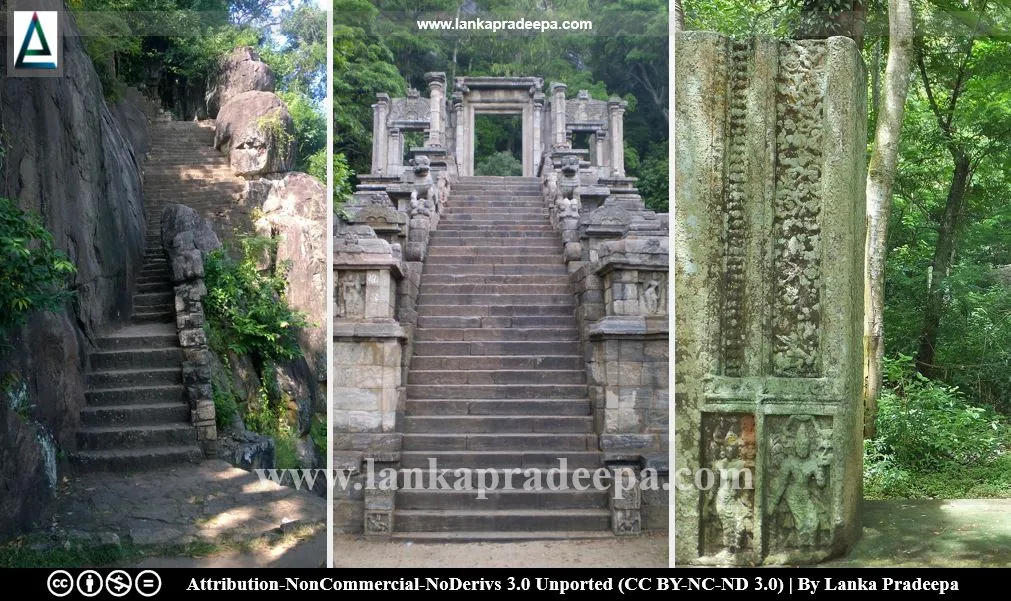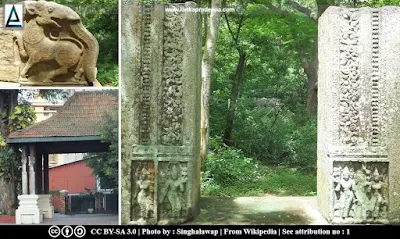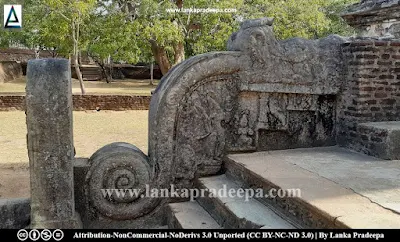
Dambadeniya Kingdom (Sinhala: දඹදෙණිය රාජධානිය/ යුගය; Tamil: தம்பதெனிய அரசு) was the third kingdom that flourished in Sri Lanka during the 13th-14th centuries (from 1232 A.D. to 1341 A.D.). The kingdom was mainly ruled through three capitals; viz: Dambadeniya, Yapahuwa, and Kurunegala.
Polonnaruwa Kingdom, the second kingdom of Sri Lanka was abandoned in the 13th century mainly due to its susceptibility to invasions from South India. Also, the struggles to grab the power of the throne among the rulers who came after King Nissankamalla (1187-1196 A.D.) had already put the country's political environment into an unstable
state (Dias et al., 2016). Magha (1215–1236 A.D.) of Kalinga (India) who came with a large
army from Malabar (Kerala) easily invaded Sri Lanka during this period and as a result of that, Polonnaruwa collapsed and Dambadeniya became the new and the third kingdom of the country (Dias et al., 2016; Sudharmawathie, 2008).
King Vijayabahu III (1232-1236 A.D.) was the first king who chose Dambadeniya as the new capital. According to ancient chronicles such as Culavamsa, the king built a new city on the summit of the Jambudoni mountain consisting of fine walls and gate towers (de Silva, 1990). The details given in the Dambadeni Asna reveal that there were two parts in the capital: the inner city and the outer city (de Silva, 1990). The inner city where the main buildings of the kingdom were located such as the Palace complex and the Temple of the Tooth Relic is said to be protected with an 18-cubit tall wall (de Silva, 1990). The outer city had three boundary walls built of stone, clay, and timber (de Silva, 1990). The remains of the clay (earth) wall are still visible at the site.
King Vijayabahu III (1232-1236 A.D.) was the first king who chose Dambadeniya as the new capital. According to ancient chronicles such as Culavamsa, the king built a new city on the summit of the Jambudoni mountain consisting of fine walls and gate towers (de Silva, 1990). The details given in the Dambadeni Asna reveal that there were two parts in the capital: the inner city and the outer city (de Silva, 1990). The inner city where the main buildings of the kingdom were located such as the Palace complex and the Temple of the Tooth Relic is said to be protected with an 18-cubit tall wall (de Silva, 1990). The outer city had three boundary walls built of stone, clay, and timber (de Silva, 1990). The remains of the clay (earth) wall are still visible at the site.
The rulers of Dambadeniya
Vijayabahu III (1232-1236 A.D.)
Parakramabahu II (1236-1270 A.D.)
Vijayabahu IV (1270-1272 A.D.)
Buwanekabahu I (1272-1284 A.D.) - Transferred to Yapahuwa
Yapahuwa was originally built by Subha, a military chief, to protect that part of the country from the Kalinga invader Magha [(1210-1230 A.D.) Modder, 1893; Nicholas, 1963]. Later, King Vijayabahu IV, during his reign, improved this old fortification and stationed his younger brother there (de Silva, 1990; Modder, 1893; Nicholas, 1963). The fortress was further improved into a great city by King Buwanekabahu I who later transferred his capital from Dambadeniya to Yapahuwa (de Silva, 1990; Nicholas, 1963).
However, after the death of King Bhuvenakabahu in 1284, the South Indian Pandyans invaded the kingdom and captured the sacred Tooth Relic of the Buddha (Nicholas, 1963). This invasion resulted in an interregnum period in the country until Parakramabahu III (1287-1293 A.D.) became the king of Sri Lanka.
The rulers of Yapahuwa
Buwanekabahu I (1272-1284 A.D.)
Polonnaruwa
Parakramabahu III, the son of Vijayabahu IV became the King of the Dambadeniya Kingdom but chose the Polonnaruwa, the second kingdom of the country, as his capital. He brought back the sacred Tooth Relic to the country by establishing diplomatic relationships with the Pandyan Kingdom.
The rulers of Polonnaruwa (Dambadeniya Kingdom)
Parakramabahu III (1287-1293 A.D.)
Kurunegala
During the 14th century, Kurunegala became the third capital of the Dambadeniya Kingdom and hence the governing centre of the country. Buwanekabahu II, the son of Buwanekabahu I succeeded Parakramabahu III and ascended the throne.
The rulers of Kurunegala
Buwanekabahu II (1293-1302 A.D.)
Parakkamabahu IV (1302-1326 A.D.)
Buwanekabahu III (1326-1335 A.D.)
Vijayabahu V (1335-1341 A.D.)
The Dambadeniya Kingdom marked its end after the reign of King Vijayabahu V. Buwanekabahu IV (1341-1351 A.D.), the son of King Vijayabahu V ascended to the throne
after his father and shifted the capital from Kurunegala to Gampola giving birth to the fourth kingdom of Sri Lanka, the Kingdom of Gampola (1341–1412 A.D).
Inscriptions
There are five inscriptions of the Dambadeni Period and four of them are dated in the reign of King Parakramabahu II (1236-1270 A.D.) while the other is dated in the reign of King Vijayabahu IV [(1270-1272) Ranawella, 2014].
# Devinuwara Slab Inscription
# Yapahuwa Rock Inscription
# Anuradhapura Pillar of Mahapa Bhuvanekabahu
King Vijayabahu IV
Four inscriptions belonging to Kurunegala Period have been discovered. Of them, one is dated in the reign of King Parakramabahu IV (1302-1326 A.D.) while the other three are dated in the reign of King Vijayabahu V [(1335-1341 A.D.) Ranawella, 2014].
King Parakramabahu IV
# Naranbedda Rock Inscription
King Vijayabahu V
Coins
The copper coinage started in the period of Polonnaruwa was continued
by the kings of Dambadenia too and was popularly known as Dambadeni Coins.
During this period, Parakramabahu II and Vijayabahu IV of Dambadeniya
and Buvanekabahu I of Yapahuwa minted a coin known as Massa with their names.
Literature
The Sinhalese literature during the Dambadeniya period was at its golden phase. Many literary works in Sinhala and Pali were written during this period by various authors including Buddhist monks and royals such as King Parakramabahu II.
Notable literary works of the Dambadeniya period
Sinhala
1) Dambadeni Asna 2) Dambadeni Katikavata3) Elu Sandas Lakuna (Bhadra Thera) 4) Kandavuru Sirita
5) Kav Silumina (Parakramabahu II) 6) Pujavaliya (Buddha Puthra Thera)
7) Saddharma Ratnavaliya (Dharmasena Thera) 8) Sidath Sangarawa (Vedeha Thera)
Sinhala Sanna
1) Anavum Pirith Sannaya 2) Anuruddha Shathaka Sannaya3) Atada Sannaya (Parakramabahu II) 4) Brahmajala Sutrartha Sannaya (Vilgammula Thera)
5) Janaki Harana Sannaya 6) Kachchayana Sannaya
7) Kav Silumina Sannaya 8) Kudusika Sannaya
9) Lakunusara Chandas Granthaya Ha Sannaya 10) Maharupa Siddhi Sannaya
11) Moggallayanayata Virith Sannaya 12) Padasadana Sannaya
13) Sachcha Sankhepa Sannaya 14) Samanera Prashna Sannaya
15) Sutra Nipatha Sannaya 16) Theli Pitapotha
17) Vinatartha Samuchchaya Sannaya (Vanarathana Medhankara Thera)
18) Visuddhimarga Sannaya (Parakramabahu II) 19) Vuththodaya Sannaya
Pali & Tika
1) Abhidharmayata Sili Pitapatha 2) Bhesajja Manjhusa (Panchamula Pirivenpathi)3) Haththavanagalla Vihara Vamsa (a student of Anodassi Thera)
4) Jina Charitha Gatha (Vanarathana Medhankara Thera)
5) Kankha Vitharana Pitapatha (Ananda Thera) 6) Pajjamadhu Gatha (Buddhappiya Thera)
7) Pali Maha Vamsa: Part II. (Dhammakitti Thera) 8) Rasavahini (Vedeha Thera)
9) Rupa Siddhi (Choliya Buddhappiya) 10) Saddhamemapayanaya
11) Samantakuta Varnana Gatha (Vedeha Thera)
12) Sambandha Chintha (Sangharakkhitha Sangharaja Thera)
13) Sikkhapada Valajhana (Panchamula Pirivenpathi)
14) Simalankara Sangraha (Vachissara Thera) 15) Simalankara Sangraha Tika
16) Subodhalankaraya (Sangharakkhitha Sangharaja Thera)
17) Susadda Siddhi Vyakarana 18) Thupavamsa (Vachissara Thera)
19) Vinaya Sarattha Dipani (Vachissara Thera) 20) Vinaya Vinishchaya Tika (Buddhadatta Thera)
21) Vuththodaya Pali Chandas
See also
Attribution
1) කුරුණෑගල කොරවක්ගල, කුරුණෑගල මඟුල් මඩුව, කුරුණෑගල දළදා මාළිගාවේ පිවිසුම by Singhalawap are licensed under CC BY-SA 3.0
References
1) de Silva, N., 1990. Sri Lankan architecture during the period 1200-1500 A.D. Wijesekara, N. (Editor in chief). Archaeological Department centenary (1890-1990): Commemorative series: Volume III: Architecture. Department of Archaeology (Sri Lanka). pp.76-77.
2) Dias, M.;
Koralage, S.B.; Asanga, K., 2016. The archaeological heritage of Jaffna
peninsula. Department of Archaeology. Colombo. p.178.
3) Modder, F.H., 1893. Ancient cities and temples in the Kurunegala
District: Yapahuwa. The Journal of the Ceylon Branch of the Royal
Asiatic Society of Great Britain & Ireland, 13(44), pp.97-114.
4) Nicholas, C. W., 1963. Historical topography of ancient and medieval
Ceylon. Journal of the Ceylon Branch of the Royal Asiatic Society, New
Series (Vol VI). Special Number: Colombo. Royal Asiatic Society (Ceylon
Branch). p.95.
5) Ranawella, S., 2014. Archaeological Survey of Ceylon: Inscriptions of
Ceylon: Vol. VII. Department of Archaeology. ISBN: 978-955-9159-62-9.
pp.xx-xxi.
6) Sudharmawathie,
J.M., 2008. Historical significance of the kingdom of Dambadeniya,
Proceedings of the Annual Research Symposium 2008, Faculty of Graduate
Studies, University of Kelaniya. p.105.
This page was last updated on 28 June 2022





